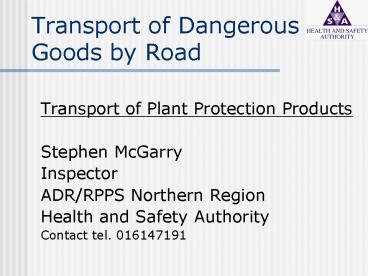Transport of Dangerous Goods by Road - PowerPoint PPT Presentation
1 / 20
Title:
Transport of Dangerous Goods by Road
Description:
Carriage of Dangerous Goods by Road Act 1998. Carriage of Dangerous Goods by Road Regulations 2004 ... carriers involved in carriage/loading/unloading (not ... – PowerPoint PPT presentation
Number of Views:1088
Avg rating:3.0/5.0
Title: Transport of Dangerous Goods by Road
1
Transport of Dangerous Goods by Road
- Transport of Plant Protection Products
- Stephen McGarry
- Inspector
- ADR/RPPS Northern Region
- Health and Safety Authority
- Contact tel. 016147191
2
Content
- Legislation
- Safety Advisers
- Duties of participants
- Driver training
- Documentation
- Packaging
- Vehicle equipment and marking
- Quantity exemptions and Limited Quantity
- Examples how much can I carry with exemptions?
- General exemptions and questions
3
Legislation
- ADR European Agreement Concerning the
International Carriage of Dangerous Goods by Road
2005 - Carriage of Dangerous Goods by Road Act 1998
- Carriage of Dangerous Goods by Road Regulations
2004 (2005 due this year and incorporates Safety
Advisers) - Fines Payment in lieu of prosecution or on the
spot fines 250 per infringement. - Up to 1900 per offence in the District Court.
4
Safety Advisers (DGSA)
- Legal requirement for consignors/carriers
involved in carriage/loading/unloading (not
consignees) - Appionted in writing
- Hold a vocational training certificate
- Duties include annual report, provide advice on
current legislation, serious accident
investigation and ensure compliance with ADR.
5
Duties of participants
- Who are the duty holders? Consignors/Carriers/Driv
ers/Loaders/Packers/Fillers/Consignees - All duty holders must comply with the regulations
/ ADR - Specific duties listed in regulations..
6
Duties of participants
- Consignors
- Transport Documentation/ instruction in writing
(tremcard) - Ensure correct classification
- Proper packaging, correct marking,
- Check suitability of driver and vehicle
- others detailed in regs.
7
Duties of participants
- Carriers
- Prior to the journey ensure all necessary
documentation is present. - Driver is trained
- Provides all necessry safety equipment
extinguishers, warning signs, first aid, spill
kit. - Vehicle marking
- Load segregation from food stuffs
- others detailed in regs.
8
Duties of participants
- Drivers
- Carry ADR driver training certificate
- Photographic i.d.
- Read and understand documentation
- Load security
- Keep vehicle marking clean
- Follow emergency procedures
- others detailed in regs.
9
Driver Training
- Drivers must complete a training course 3 days
for packaged goods and 5 days if working on road
tankers. - Trainers see HSA web site.
- Exams set by the HSA basic paper and a tanker
specialisation paper. - Driver training certificate valid for 5 years.
- Certificates detail what classes are held and
whether packages only or packages and tanks.
10
Documentation
- Transport document consignor details,
identification of substance, number and size of
packages and total weight/volume, consignee(s), - additional information for certain classes
note any special provisions e.g. for waste or
empty unclean packaging - Substance I.d. UN3082,environmentally
hazardous substance, liquid,n.o.s (technical
name), 9, PGIII
11
Documentation
- Instructions in writing (tremcards)
- Must conform to specific format. It identifies
the substance, nature of danger, general actions
to be taken in an emergency, how to deal with
minor spills, additional equipment. - Can be obtained from CEFIC authorised outlets
see HSA website.
12
Packaging
- Must conform to ADR requirements
- Choose correct package and note any special
packaging provisions - When in use look for UN marking/ UN number
- Ensure correct labelling
- UN approved does not mean it can be used for all
hazardous goods there is a range of different
types of packaging. - Note - reusable plastic containers have a shelf
life
13
Vehicle equipment and marking
- High-visibility jacket
- Hand lamp
- 2 warning signs
- Wheel scotch
- 2 kg6kg extinguishers (serviced annually)
- Items listed on tremcard
- Spill kit / first aid/ eye wash/ ppe
14
Vehicle equipment and marking
- Package goods vehicle only mark vehicle with
ADR blanc orange plates front and rear (
placards ie class label, for freight containers
and sea journey)
15
Quantity exemptions and Limited Quantity (LQ)
- Quantity exemptions (ADR 1.1.3.6)
- All dangerous goods are assigned a transport
category, each with a quantity limit, at or below
which you may avail of certain exemptions, e.g.
no vehicle marking, no tremcard, no ADR driver
training, no safety equipment (except 2kg
extinguisher)
16
Quantity exemptions and limited quantity (LQ)
- Limited Quantity (LQ) - small packages but no
overall limit on quantity. - Good quality packaging marked with a diamond
containing LQ or UN number. - Once you meet the marking and packaging
requirements no other provisions apply.
17
Example
- You wish to transport Product-X,
- UN 2902,4x5 litre, class 6.1, PGIII
- LQ for combination packaging up to 3 litre inner
pack with 30kg maximum net mass package not LQ. - Quantity exemption for PGIII is 1000litres may
be carried under this exemption.
18
Example
- Large mixed consignment.
- Identify all LQ shipments and remove from
equation - Identify all other hazardous shipments and add
net quantity together ( multiply PGII goods by 3)
and if 1000 or less then quantity exemption may
apply - If over 1000 then all provisions apply.
19
Exemptions
- No certified driver if vehicle is less than 3.5
tonne gross mass (only until Jan 2007). - No DGSA required if under quantity exemption
limits and if transporting lt50 tonne per year and
no load over 3 x quantity exemption limit. - No transport document for pesticides class 3
(FT2) and class 6 (T6 liquid) if less than
quantity exemption(1.1.3.6). - Otherwise too numerous to mentionconsult a DGSA
or the HSA.See details in the regulations.
20
Questions..































